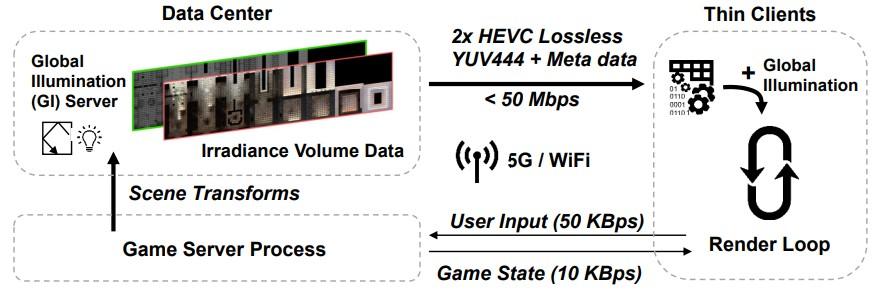A distributed, decoupled system for losslessly streaming dynamic light probes to thin clients

We present a networked, high-performance graphics system that combines dynamic, high-quality, ray traced global illumination computed on a server with direct illumination and primary visibility computed on a client. This approach provides many of the image quality benefits of real-time ray tracing on low-power and legacy hardware, while maintaining a low latency response and mobile form factor.
As opposed to streaming full frames from rendering servers to end clients, our system distributes the graphics pipeline over a network by computing diffuse global illumination on a remote machine. Diffuse global illumination is computed using a recent irradiance volume representation combined with a new lossless, HEVC-based, hardware-accelerated encoding, and a perceptually-motivated update scheme.
Our experimental implementation streams thousands of irradiance probes per second and requires less than 50 Mbps of throughput, reducing the consumed bandwidth by 99.4% when streaming at 60 Hz compared to traditional lossless texture compression.
The bandwidth reduction achieved with our approach allows higher quality and lower latency graphics than state-of-the-art remote rendering via video streaming. In addition, our split-rendering solution decouples remote computation from local rendering and so does not limit local display update rate or display resolution.
Publication Date
Published in
Uploaded Files
Copyright
Copyright by the Association for Computing Machinery, Inc. Permission to make digital or hard copies of part or all of this work for personal or classroom use is granted without fee provided that copies are not made or distributed for profit or commercial advantage and that copies bear this notice and the full citation on the first page. Copyrights for components of this work owned by others than ACM must be honored. Abstracting with credit is permitted. To copy otherwise, to republish, to post on servers, or to redistribute to lists, requires prior specific permission and/or a fee. Request permissions from Publications Dept, ACM Inc., fax +1 (212) 869-0481, or permissions@acm.org. The definitive version of this paper can be found at ACM's Digital Library http://www.acm.org/dl/.
